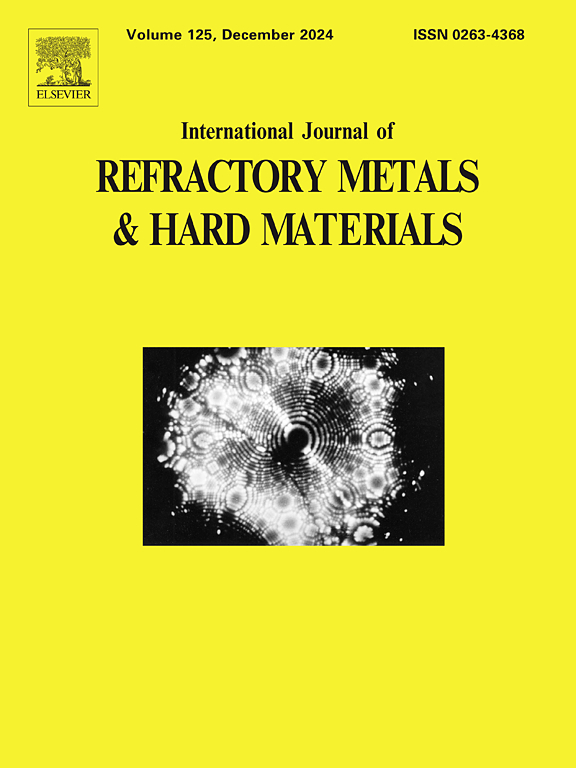A new study on the electrochemical behavior and thermal stability of W–4.9Ni–2.1Fe–xAl2O3 composites
IF 4.2
2区 材料科学
Q2 MATERIALS SCIENCE, MULTIDISCIPLINARY
International Journal of Refractory Metals & Hard Materials
Pub Date : 2024-11-23
DOI:10.1016/j.ijrmhm.2024.106972
引用次数: 0
Abstract
The present study investigates the influence of adding micro/nanoparticles of Al2O3 (0.5–1.5 wt%) on the microstructure, electrochemical behavior, and thermal stability of a W-Ni-Fe matrix sintered by the spark plasma process. Corrosion characteristics were assessed through Tafel polarization and electrochemical impedance spectroscopy techniques in a 0.1 M HCl solution. The extent of corrosion was evaluated by examining the specimen surfaces before and after the corrosion test using field emission scanning electron microscopy and x-ray diffraction methods. Additionally, thermo-gravimetric analysis was employed to investigate the weight loss behavior and thermal stability of the composites up to 1000 °C in dry air atmosphere. The nanoparticles of Al2O3 significantly enhanced the corrosion resistance of the W–4.9Ni–2.1Fe matrix, with up to 90 % improvement observed in the presence of 1 wt% nanoparticles in the HCl solution. The uniform dispersion of nanoparticles throughout the matrix caused a decrease in the grain size and the cathodic area. Furthermore, the nanocomposites exhibited superior thermal behavior and minimal weight changes, as indicated by the thermoanalytical results. The thermal stability of the composites was assessed, and it was found that the specimen incorporating 1 wt% nanoparticles exhibited the greatest thermal stability, characterized by a 6 % enhancement in thermal resistance.
关于 W-4.9Ni-2.1Fe-xAl2O3 复合材料的电化学行为和热稳定性的新研究
本研究探讨了添加 Al2O3 微/纳米颗粒(0.5-1.5 wt%)对火花等离子工艺烧结的 W-Ni-Fe 基体的微观结构、电化学行为和热稳定性的影响。在 0.1 M HCl 溶液中,通过塔菲尔极化和电化学阻抗光谱技术评估了腐蚀特性。在腐蚀试验前后,使用场发射扫描电子显微镜和 X 射线衍射方法检查试样表面,评估腐蚀程度。此外,还采用了热重分析法来研究复合材料在干燥空气环境中 1000 ℃ 下的失重行为和热稳定性。Al2O3 纳米粒子显著增强了 W-4.9Ni-2.1Fe 基体的耐腐蚀性,在盐酸溶液中添加 1 wt% 纳米粒子时,耐腐蚀性可提高 90%。纳米粒子在整个基体中的均匀分散导致晶粒尺寸和阴极面积减小。此外,热分析结果表明,纳米复合材料具有优异的热性能,重量变化极小。对复合材料的热稳定性进行了评估,结果发现,含有 1 wt% 纳米粒子的试样具有最强的热稳定性,热阻提高了 6%。
本文章由计算机程序翻译,如有差异,请以英文原文为准。
求助全文
约1分钟内获得全文
求助全文
来源期刊
CiteScore
7.00
自引率
13.90%
发文量
236
审稿时长
35 days
期刊介绍:
The International Journal of Refractory Metals and Hard Materials (IJRMHM) publishes original research articles concerned with all aspects of refractory metals and hard materials. Refractory metals are defined as metals with melting points higher than 1800 °C. These are tungsten, molybdenum, chromium, tantalum, niobium, hafnium, and rhenium, as well as many compounds and alloys based thereupon. Hard materials that are included in the scope of this journal are defined as materials with hardness values higher than 1000 kg/mm2, primarily intended for applications as manufacturing tools or wear resistant components in mechanical systems. Thus they encompass carbides, nitrides and borides of metals, and related compounds. A special focus of this journal is put on the family of hardmetals, which is also known as cemented tungsten carbide, and cermets which are based on titanium carbide and carbonitrides with or without a metal binder. Ceramics and superhard materials including diamond and cubic boron nitride may also be accepted provided the subject material is presented as hard materials as defined above.

 求助内容:
求助内容: 应助结果提醒方式:
应助结果提醒方式:


